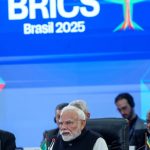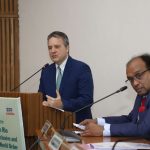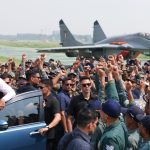 India’s External Affairs Minister Sushma Swaraj’s August 8-11 visit to Myanmar has put the spotlight on the importance India’s new government is placing on nurturing relations with the country’s neigbours. In Myanmar, the minister will hold wide-ranging bilateral talks with Myanmar’s top leadership and attend a host of ministerial meetings connected with ASEAN, the Asean Regional Forum and the East Asia Summit.
India’s External Affairs Minister Sushma Swaraj’s August 8-11 visit to Myanmar has put the spotlight on the importance India’s new government is placing on nurturing relations with the country’s neigbours. In Myanmar, the minister will hold wide-ranging bilateral talks with Myanmar’s top leadership and attend a host of ministerial meetings connected with ASEAN, the Asean Regional Forum and the East Asia Summit.
In this conversation with Manish Chand, Editor-in-Chief, India Writes Network (www.indiawrites.org), Rajiv Bhatia, Director-General of Indian Council of World Affairs (ICWA) and a former Indian envoy to Myanmar, speaks about the future trajectory of India’s multi-layered relation with Myanmar, the importance of the minister’s first visit to Southeast Asia and New Delhi’s burgeoning relations with ASEAN and the East Asia region.
(Excerpts from the interview)
Q) India’s external affairs minister is currently on her first visit to Myanmar. How do you look at the importance of the minister’s first visit to an ASEAN country?
A) First of all, this is clearly a continuing outreach mission by India to its neighbours. Myanmar is our immediate and important neighbour, a country which is important for our political, economic and strategic interests. In light of what is happening in the last three-four years this visit by India’s external minister would draw attention, and will be closely watched.
Q) What will be key issues on the table?
A) As a scholar, one can certainly say that there is a national consensus on India’s Myanmar policy. It was during the first NDA’s tenure that a very strong push was given for consolidation and expansion of relations with Myanmar, a process which continued for the next decade. We can safely assume that the focus will be not merely only consolidation but also its expansion. In specific terms, there will be an endeavour to deepen political understanding, exchange of view on the lager regional issues, and undoubtedly this will be an occasion for the minister to focus on expediting the implementation of a number of bilateral cooperation projects.
 Q) In what areas do you see this relationship expanding in the future?
Q) In what areas do you see this relationship expanding in the future?
A) I think all the three or four pillars are important. The pillar of border management and connectivity is important. The question of expanding development cooperation is important, and so is the field of security and defence. However, economic cooperation is of greatest importance. As we monitor and study developments closely, we can say there are three or four projects which are registering progress, there is one in the field of setting up a major agricultural cooperation institute; the indication are that they will be completed by the end 2014. There is also a major project in regards to capacity building in terms of information technology which is expected to be ready by the end of next year. That leaves two other major projects: the Tri-lateral highway project and the Kaladan multimodal transit and transport project. On those two, there is an attempt to speed up the implementation; this will be an opportunity for the minister to share with people, both in the region and in India, how things have been moving forward.
Q) There is a huge potential in the agricultural sector. Some experts say Myanmar could become critical for India’s food security. How do you see cooperation developing in this area?
A) In the last couple of years a fairly good focus has been placed on it. For a long period India has been a major importer of pulses from Myanmar; earlier we also imported a great amount of rice from there. First of all, in terms of trade more can be done, secondly in terms of enhancing Myanmar’s capability to produce more with the help of appropriate technology is where India can, and is, helping Myanmar. Going beyond that, there is also the question of putting more land to cultivation; not directly by the any of our people – that will have to be done by Myanmar, but by putting more resource into the agricultural sectors perhaps we can do more.
Q) How do you look at energy cooperation between the two countries?
A) I have to project a certain degree of optimism; there has already been a base that has been secured in the past decade. But in the last years or so, two Indian companies have won two new oil and gas blocks, depending on how their exploration work goes forward in those sectors, there can be more that may be achieved in energy cooperation between India and Myanmar. I think energy cooperation has good potential. Therefore, instead of focusing on what we lost in the past it is important to try to consolidate what we have gained, and also look for more opportunities to gain more oil and gas blocks in the future from Myanmar.
Q) Given Myanmar’s geo-strategic location, do you think India needs to scale up security cooperation with Myanmar?
A) First of all, with regard to the internal security aspect of national security, it is very clear that this long border of 1643 kilometres is very sensitive, we have been hearing how the BSF is going to be assigned to this area and be responsible for the India-Myanmar border. We must recognise that we still continue to receive reports of negative activities at the border. Clearly, there will be serious discussion on how the cooperation between the two countries is shaping up in this. We could expect Myanmar to do more in terms of helping us, in terms of insurgency, narcotics, and illegal trade. But at the same time, the fact remains, we too have to step up and do more.
 Q) This will be the first high-profile engagement of the new Indian government with the ASEAN and East Asia region. How do you look at the importance of the ARF ministerial grouping for India’s economic and security interest?
Q) This will be the first high-profile engagement of the new Indian government with the ASEAN and East Asia region. How do you look at the importance of the ARF ministerial grouping for India’s economic and security interest?
A) The ASEAN Regional Forum (ARF) is an important pillar for the regional economic and political architecture today; it is an old institution set in 1993, and India joined it a few years later in 1996. The ministerial meeting is the highest level meeting where exchanges take place; these are preceded by different senior diplomatic and political officials. This is not India and ASEAN, this is a 27-member organisation. Apart from the countries of ASEAN and their dialogue partner India and Russia, there are other countries from South Asia, EU, Canada and others which are members. The larger security issue like confidence building measure, the subject of preventive diplomacy, the question of maritime security, all these issues get discussed at ARF. In the forthcoming meeting in Nay Pyi Taw, the focus will be on recent happenings, the developments in South China Sea and East China Sea. This whole question of progress, or the lack thereof, of dialogue between India and ASEAN on developing a functioning code of conduct. They already have a declaration on code of conduct, but it is important that countries respect international law, and resolve interstate disputes through peace without resorting to force or the threat of force; this would be an occasion to see that there is no disconnect, or as little disconnect as possible, between what states say and what they actually do.
 Q) What are India’s contributions to debates and discussion about regional security? Where are we vis-à-vis major security issues covered by the ARF?
Q) What are India’s contributions to debates and discussion about regional security? Where are we vis-à-vis major security issues covered by the ARF?
A) This subject has already been reviewed at the level of senior officials last month. Not that much information is in the public domain; therefore, I can assume that India would be first of all in a listening mode. Second, India would be in a pleading and lobbying mode to ensure that the region remains a peaceful and secure region, like others our bottomline is to focus on economic development. The current dialogue about reforming the regional architecture for security and economic cooperation needs to go ahead. India has been playing a very active role at the track two level, and some of this will get reflected in ministerial discussion that will take place in Myanmar.
Q) Are you satisfied with the broad trajectory of India’s Look East Policy?
A) I think this is very pertinent question and this is where I want focus my basic concept; if we take Madam Sushma Swaraj’s visit to Myanmar, which will be followed up by the visit of the prime minister for the participation in the meetings in November, this would put a very focused light on the advancement India’s Look East policy has been making. This policy has been aptly described as the cornerstone of India’s foreign policy. This is anchored in strong national consensus. The policy began in the times of Prime Minister Narshimha Rao in the 90s, it received a major fillip during the NDA government under Prime Minister Vajpayee, and then it was moved forward under the tenure of Prime Minister Manmohan Singh. I have a very clear perception that now it would be not merely the phase of consolidation but further expansion and deepening. That is why this talk about Enhanced Look East Policy or LEP 3.0 is going to be a reality.
At three different levels: at the level of ASEAN, at the level of sub-ASEAN, i.e. in the sub-ASEAN tier of BIMSTEC , MGC etc, and, above all, at the level of extra-ASEAN relationships involving China, Japan, US, Australia, and Republic of Korea. By December 2014, we are going to see LEP making significant strides and this would be very good for economic development and security and prosperity of our country.
Author Profile
- India Writes Network (www.indiawrites.org) is an emerging think tank and a media-publishing company focused on international affairs & the India Story. Centre for Global India Insights is the research arm of India Writes Network. To subscribe to India and the World, write to editor@indiawrites.org. A venture of TGII Media Private Limited, a leading media, publishing and consultancy company, IWN has carved a niche for balanced and exhaustive reporting and analysis of international affairs. Eminent personalities, politicians, diplomats, authors, strategy gurus and news-makers have contributed to India Writes Network, as also “India and the World,” a magazine focused on global affairs.
Latest entries
 India and the WorldJuly 7, 2025BRICS boost for India, Modi calls out double standards on terror
India and the WorldJuly 7, 2025BRICS boost for India, Modi calls out double standards on terror India and the WorldJuly 6, 2025Expanded BRICS will play key role in global governance reforms: Brazil’s Envoy
India and the WorldJuly 6, 2025Expanded BRICS will play key role in global governance reforms: Brazil’s Envoy India and the WorldJune 26, 2025Operation Sindoor: India Sheds Restraint, Rediscovers Utility of Force
India and the WorldJune 26, 2025Operation Sindoor: India Sheds Restraint, Rediscovers Utility of Force India and the WorldJune 23, 2025BRICS summit in Rio to focus on Global South, local currency trade
India and the WorldJune 23, 2025BRICS summit in Rio to focus on Global South, local currency trade







